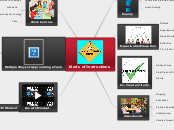Engaging Beginners, Reading Supports for All, and Classroom conversations: Opportunities to learn for ESL students in mainstream classrooms
When assessing ESL students, asses on content and not language
How do you know what stage your students are at?
Talk to your student's about their environment at home
Maybe even visit that community and see what it's like
Observation
Listen to the way your ESL students speak
Strategies for teaching ESL students
Creating a community in the classroom
Use terms such as...
Community
Partners
Together
Our
We
Make sure all students are able to speak in class
Use discussions, call on all students
Believe in ALL students
Don't ever have low expectations for a student,
especially if they are in the preproduction stage
Listen to ALL students
Make an effort to understand your ESL students,
even if their answers are confusing
Understanding
Know each student's stage of language acquisition
Fluent in English, up to native-level speaking fluency
Great comprehension, little errors in grammar
Can produce simple sentences
One or two word responses
Less verbal, nods yes and no
Language usage/communication
Avoid slang and idioms
Make sure that any ESL student will understand your language
Be aware of your facial responses
Use gestures
Teach academic language
Teaching
For reading, use scaffolded reading experiences
Split the reading comprehension work into three parts
Post-reading
Discussions, connecting the passages, answering questions
During-reading
Guided reading, silent reading, simplifying the passages or chapters, using the home language of ESL students
Pre-reading
Teaching vocabulary that students will run into, discuss background knowledge of subject, discuss reading strategies
Use different kinds of assessments
Use manipulatives
Art projects
Projects
Discussions
Have high expectations for ALL students
All students should learn the content, but consider each student's language acquisition stage
Tiered assignments (writing examples)
Essay questions, explanations
If...then questions, cause and effect questions
Completing a fill-in-the-blank worksheet (crossword puzzle for example)
Answering simple questions, adding a few challenge questions
Drawing a picture, adding yes or no questions
Tiered questions for each stage (examples)
Advanced fluency
"Retell this situation as..." (Questions requiring essay-like responses)
Intermediate fluency
"What would happen if this happened..." (Questions requiring more than one-sentence answers)
Speech emergence
"Why?" "How?" (Questions requiring more than one word responses)
Early production
Yes or no questions (Questions with one-word answers)
Preproduction
"Show me..." "Where is..."









